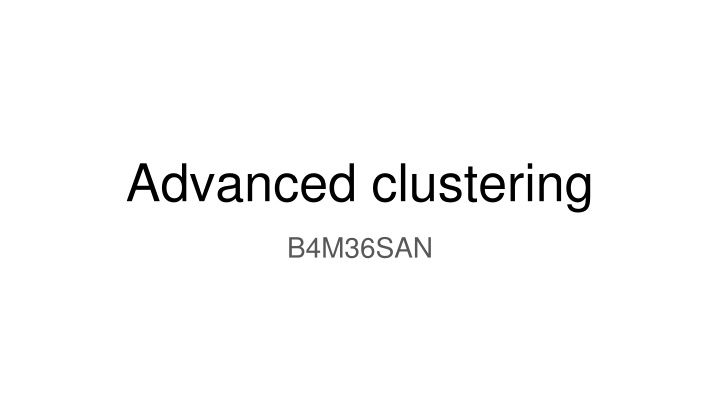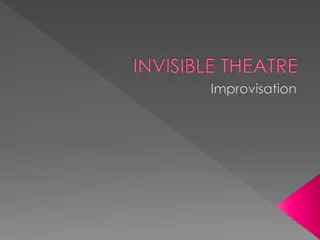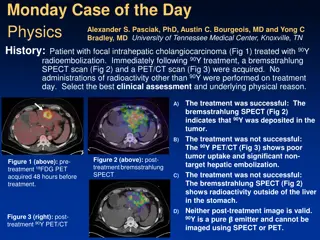
Advanced Clustering Methods Overview and Implementation Techniques
"Explore a comprehensive guide to advanced clustering techniques such as K-means, Hierarchical clustering, DBSCAN, and Spectral clustering. Learn about their advantages, limitations, and practical applications through DIY implementation. Discover the relationships between K-means, PCA, and LDA, along with insightful tips on initialization methods and dataset experimentation."
Download Presentation

Please find below an Image/Link to download the presentation.
The content on the website is provided AS IS for your information and personal use only. It may not be sold, licensed, or shared on other websites without obtaining consent from the author. If you encounter any issues during the download, it is possible that the publisher has removed the file from their server.
You are allowed to download the files provided on this website for personal or commercial use, subject to the condition that they are used lawfully. All files are the property of their respective owners.
The content on the website is provided AS IS for your information and personal use only. It may not be sold, licensed, or shared on other websites without obtaining consent from the author.
E N D
Presentation Transcript
Advanced clustering B4M36SAN
Outline 1. Review of baseline methods K-means, Hierarchical clustering, DBSCAN 2. Spectral clustering Principles and intuition, Showcase DIY implementation 3. K-means on steroids Relation to LDA and PCA Ensemble clustering For the mother-cluster! kmeans kmeans kmeans kmeans kmeans kmeans
K-means Advantages: + Fast, easy, simple Susceptible to: Cluster shapes and densities Initialization Outliers - Predefined number of clusters*
Hierarchical clustering Advantages: + More informative hierarchical structure + Can vary number of clusters without re-computation Susceptible to: Noise (single link) Outliers (complete link) Non-spherical clusters (average link)
DBSCAN Advantages: + Cluster shapes are not an issue + Robust towards outliers/noise Susceptible to: Cluster densities Parametrization (eps, MinPts)
Datasets Jain dataset 2 spirals dataset Experiment yourself
Spectral clustering Turns data into a graph Finds a min-cut of the graph The partition forms the clusters Simple idea, not so simple steps
Why 2nd eigenvector? 2nd eigenvector is f, that minimizes this function (without proof) But what is this function telling? It s a cost function! If two points are connected i.e sij=1, it penalizes the difference in their labels
K-means relation to PCA and LDA Initialization issues Repeated starts PCA-Part A divisive hierarchical approach based on PCA. Starting from an initial cluster that contains the entire data set, the iteratively select the cluster with the greatest SSE and divide it into two subclusters using a hyperplane that passes through the cluster centroid and is orthogonal to the principal eigenvector of the cluster covariance matrix. This procedure is repeated until K clusters are found Celebi, M.E., Kingravi, H.A. and Vela, P.A., 2013. A comparative study of efficient initialization methods for the k-means clustering algorithm.
K-means relation to PCA and LDA LDA Assumes data for each class come from (mulitvar.) normal distributions Uses Bayes theorem to decide which class a sample belongs to EM-GMM clustering Soft version of K-means Also assumes data for each cluster come from (mulitvar.) normal distributions The parameters estimated are c, cand pcof the clusters
EM clustering on Breast cancer dataset Demo in the ./extra folder of the course materials
How to generate clusters? Using different clustering algorithms e.g. K-means, hierarchical clustering, spectral clustering, Running the same algorithm with different parameters or initializations, e.g., use different dissimilarity measures use different number of clusters Using different samples of the data
How to combine the partitions? Median partition based approaches Averaging all ensemble partitions Co-occurrence based approaches Relabeling/voting based methods Co-association matrix based methods Graph based methods
Resources http://www.cse.msu.edu/~cse802/EnsembleClustering_Jinfeng_jain.pptx https://stanford.edu/~cpiech/cs221/handouts/kmeans.html https://csdl-images.computer.org/trans/tk/2012/03/figures/ttk20120304131.gif https://www.researchgate.net/figure/An-example-of-the-Laplacian-matrix-of-a-simple-network-n-4_fig1_305653264 https://images.amcnetworks.com/ifc.com/wp-content/uploads/2015/03/EnemyAtTheGates_MF.jpg https://gfycat.com/somelonelycaterpillar Luxburg07_tutorial_spectral_clustering.pdf (mit.edu) [1209.1960] A Comparative Study of Efficient Initialization Methods for the K-Means Clustering Algorithm (arxiv.org) Rajaraman, Anand, and Jeffrey David Ullman. Mining of massive datasets. Cambridge University Press, 2011.



